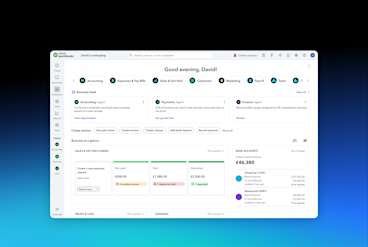
Cloud accounting
Automation vs AI vs Agentic: What every accountant should know
Simple, smart accounting software - no commitment, cancel anytime

STARTING YOUR OWN BUSINESS
If you’re starting your own business in the UK, you’ll need a lot in place before you can start attracting investors and operating. In addition to a workable idea and a sense of the overall market, you need to summarise what your business will do and how it will do it. For that, you need a business plan.
In this article, we’ll cover all the essentials you need to know, from what a business plan is and why it matters to how to write one.
A business plan is a detailed summary of what your business will be and what it will do. You should produce one after conducting market research and setting up your budget.
You can think of writing a business plan as the final step in the planning process you go through when starting a business.
A business plan should cover areas such as:
objectives
strategies
sales
marketing
financial forecasts
At the start of your business plan, you should also include an executive summary – a shorter section that condenses the overall report and highlights key points.
Business plans have obvious external uses. You need a document to show to potential investors, for instance, or to persuade your business bank to lend to you.
On top of that, though, a business plan is crucial in making sure you’re ready to move forward with your business idea.
You need a business plan for a number of other purposes too:
To clarify your business idea for yourself and others. In setting out your strategy for the next year or more, you’ll likely encounter questions you hadn’t considered. Producing a business plan ensures you’ll work through them systematically, sharpening and strengthening your business idea.
To set and map out your goals. Writing a business plan means producing clear, concrete goals. By this stage, you can’t afford to be vague or overly general. As you work through the plan, you should find yourself dropping things that aren’t worth prioritising and going into more detail on things that are.
To spot potential problems. As with most things, putting your business ideas in writing can help you identify issues you hadn’t spotted before. This is especially true when you’re considering strategies. If you can’t develop a clear idea of how you’ll reach a certain goal, it might be worth revising that goal.
To measure progress. Finally, once you’re up and running, you’ll need to check how reality is measuring up against your expectations. Gathering and analysing quality data on your operations is a major part of business success, of course, and having a plan to compare to can help you spot areas you need to change.
Now that we’ve established what a business plan is and why it’s so important to have one, let’s turn to how to produce one.
What makes your product or service unique? Who are your competitors? Where are the opportunities in the market and why will your business be able to exploit them?
A good business plan will answer each of these questions, and do so realistically.
To achieve that, you need to produce a strong analysis of your strengths and weaknesses using a SWOT analysis.
SWOT analysis
A SWOT analysis categorises your findings as strengths, weaknesses, opportunities and threats.
Identify your strengths and weaknesses by looking at the resources you have available, from cash reserves to premises and from production equipment to workers. Compare these to your projected costs and revenue and analyse how you’d respond to a loss in one of these key areas.
For opportunities and threats, look outside your business to the wider industry. Keep an eye on market trends and competitor activities, as well as any likely changes in regulation that will impact the sector.
Time is money, and battling through overly long and unnecessary sentences to grasp a nugget of relevant information isn’t a particularly worthwhile use of either.
Keep your business plan concise. Eliminate waffle. Focus on what your readers need to know.
Short plans are less likely to be skimmed through and shelved and are much easier to refer back to at a later date.
It can be tempting to err on the side of optimism – to be a little too rosy about things like costs and sales. This is understandable. It’s easy to assume investors would shy away from anything that acknowledged too much risk, and you could even discourage yourself by being too pessimistic.
However, you should be careful not to fall into this trap. While you don’t want to begin producing your business plan with too gloomy an outlook, you’re ultimately setting yourself up for failure if you go too far the other way.
Some of the most common mistakes to avoid are:
under budgeting – thinking, or hoping, that things will cost less than they will and failing to set aside enough revenue to meet costs and fuel growth
expecting fast sales – assuming that your business will do huge numbers right out of the gate
relying too heavily on one or two customers or suppliers – tying your business’s success too closely to that of another; even if your strategy is based around direct sales to one or two big buyers, you should consider your options if those sales dry up
One way to help avoid these traps is to consider ‘what-if’ scenarios. In the absence of a working crystal ball, you can’t know for sure whether your predictions are accurate. Even the best assumptions can turn out to be fundamentally flawed. The problem is this revelation comes too late to do anything about it.
To avoid this, prepare for a wide range of outcomes; have a plan in place to deal with a sudden slump in sales, for instance, or a shortage in supplies.
This might seem less important than the other points on this list, but professionalism isn’t just a question of presentation. It also means keeping your information, analysis and projections in clearly defined sections – and, in turn, keeping your thoughts clear.
As always, you should keep one eye on your potential audience.
It’s good practice to include more detailed information such as financial forecasts and market analysis, for instance, but putting them in the main body of the report can be distracting, drawing the focus away from your specific goals and strategies. To avoid this, include such supplementary material in appendices.
Similarly, you should produce a contents page, so your readers aren’t forced to fight their own way through page after page of writing to find the information they’re looking for.
You should never produce a business plan alone. Even the most experienced professionals can benefit from getting another set of eyes on their work.
Getting feedback from others will help highlight issues you haven’t fully explained and can draw your attention to areas you’ve missed entirely.
Finally, you should make sure you don’t shelve your business plan once you’re up and running. The best predictions can prove mistaken, and you’ll benefit from comparing your actual performance to your expectations.
Having a good benchmark lets you evaluate how your company is doing as you move forward and can help you make more accurate predictions in future, enabling you to make better plans as things develop.
Similarly, adjusting your business plan as you go will help keep you responsive, improving your ability to adapt to unexpected changes.
You’re ready to write your business plan
We hope you found this guide to business plans helpful. If you need more resources, The Prince’s Trust has a free-to-use business plan template. If you’re looking for advice on what to do before and after writing a business plan, our guide to starting your own business in the UK can help. Fill out the short questionnaire to get a personalised to do list sent straight to your inbox.
Subscribe to get our latest insights, promotions, and product releases straight to your inbox.
9.00am - 5.30pm Monday - Thursday
9.00am - 4.30pm Friday